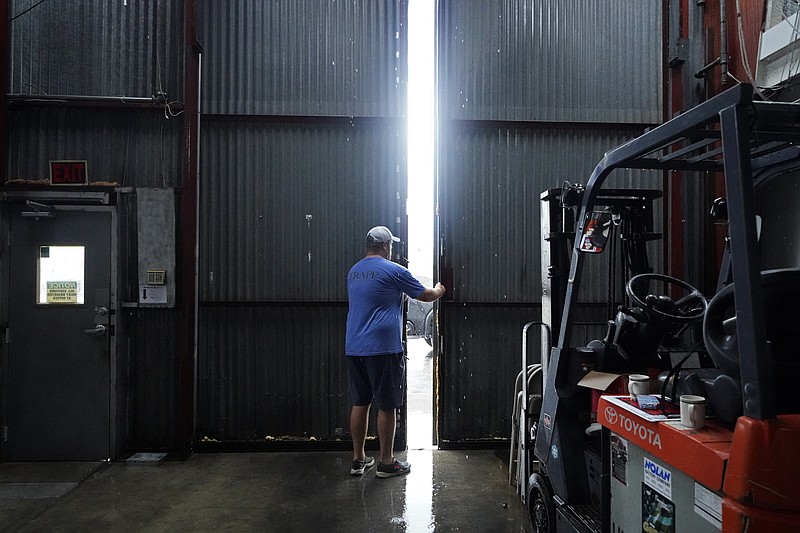SURFSIDE BEACH, Texas (AP) - Tropical Storm Nicholas slowed to a crawl over southeastern Texas and southwestern Louisiana Tuesday after blowing ashore as a hurricane, knocking out power to a half-million homes and businesses and dumping more than a foot of rain along the same area swamped by Hurricane Harvey in 2017.
Nicholas could potentially stall over storm-battered Louisiana and bring life-threatening floods across the Deep South over the coming days, forecasters said.
Nicholas made landfall early Tuesday on the eastern part of the Matagorda Peninsula and was soon downgraded to a tropical storm. It was about 50 miles east of Houston, with maximum winds of 40 mph as of 4 p.m. CST Tuesday, according to the National Hurricane Center in Miami. However, weather radar showed the heaviest rain Tuesday afternoon was over southwestern Louisiana, well east of the storm center.
The storm is moving east-northeast at 6 mph. A tropical storm warning remained in effect from High Island, Texas, to Cameron, Louisiana. The National Hurricane Center said the storm may continue to slow and even stall, and although its winds will gradually subside, heavy rainfall and a significant flash flood risk will continue along the Gulf Coast for the next couple days.
Galveston, Texas, had nearly 14 inches of rain from Nicholas, the 14th named storm of the 2021 Atlantic hurricane season, while Houston reported more than 6 inches of rain. That's a fraction of what fell during Harvey, which dumped more than 60 inches of rain in southeast Texas over a four-day period.
In the small coastal town of Surfside Beach about 65 miles south of Houston, Kirk Klaus, 59, and his wife Monica Klaus, 62, rode out the storm in their two-bedroom home, which sits 6-8 feet above the ground on stilts.
"It was bad. I won't ever do it again," Kirk Klaus said.
He said it rained all day on Monday and, as the night progressed, the rainfall and winds got worse.
Sometime around 2:30 a.m. Tuesday, the strong winds blew out two of his home's windows, letting in rain and forcing the couple to continually mop their floors. Klaus said the rainfall and winds created a storm surge of about 2 feet in front of his home.
"It looked like a river out here," he said.
Nearby, Andrew Connor, 33, of Conroe, had not been following the news at his family's rented Surfside Beach vacation house and was unaware of the storm's approach until it struck. The storm surge surrounded the beach house with water, prompting Connor to consider using surfboards to take his wife and six children to higher ground if the house flooded.
The sea never made its way through the door, but it did flood the family sport utility vehicle, Connor said.
"When I popped the hood, I had seaweed and beach toys and all that stuff in my engine," he said.
Nicholas is moving so slowly it will dump several inches of rain as it crawls over Texas and southern Louisiana, meteorologists said. This includes areas already struck by Hurricane Ida and devastated last year by Hurricane Laura. Parts of Louisiana are saturated with nowhere for the extra water to go, so it will flood, University of Miami hurricane researcher Brian McNoldy said.
"It's stuck in a weak steering environment," McNoldy said Tuesday. So while the storm itself may weaken "that won't stop the rain from happening. Whether it's a tropical storm, tropical depression or post-tropical blob, it'll still rain a lot and that's not really good for that area."
The storm was moving east-northeast at 7 mph, and the center of Nicholas was expected to move slowly over southeastern Texas on Tuesday and over southwestern Louisiana today.
More than a half-million homes and businesses had lost power in Texas, but that number dropped to about 375,000 by midday Tuesday, according to the website poweroutage.us that tracks utility reports. Most of those outages were caused by powerful winds as the storm moved through overnight, utility officials said. Across Louisiana, about 100,000 customers remained without power Tuesday midday.
Nicholas brought rain to the same area of Texas that was hit hard by Harvey, which was blamed for at least 68 deaths, including 36 in the Houston area. After Harvey, voters approved the issuance of $2.5 billion in bonds to fund flood-control projects, including the widening of bayous. The 181 projects designed to mitigate damage from future storms are at different stages of completion.
McNoldy, the hurricane researcher, said Nicholas is bringing far less rain than Harvey did.
"It's not crazy amounts of rain. It isn't anything like Hurricane Harvey kind of thing with feet of rain," McNoldy said. Harvey not only stalled for three days over the same area, it moved a bit back into the Gulf of Mexico, allowing it to recharge with more water. Nicholas won't do that, McNoldy said.
Nicholas, expected to weaken into a tropical depression by Tuesday night, could dump up to 20 inches of rain in parts of southern Louisiana. Forecasters said southern Mississippi, southern Alabama and the western Florida Panhandle could see heavy rainfall as well.
On Tuesday, heavy rains from Nicholas pelted blue tarps that covered roofs damaged by Ida all over southern Louisiana.

